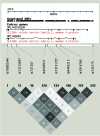Genome-wide association study of biochemical traits in Korcula Island, Croatia
- PMID: 19260141
- PMCID: PMC2657564
- DOI: 10.3325/cmj.2009.50.23
Genome-wide association study of biochemical traits in Korcula Island, Croatia
Abstract
Aim: To identify genetic variants underlying biochemical traits--total cholesterol, low-density lipoprotein (LDL) cholesterol, high-density lipoprotein (HDL) cholesterol, triglycerides, uric acid, albumin, and fibrinogen, in a genome-wide association study in an isolated population where rare variants of larger effect may be more easily identified.
Methods: The study included 944 adult inhabitants of the island of Korcula, as a part of larger DNA-based genetic epidemiological study in 2007. Biochemical measurements were performed in a single laboratory with stringent internal and external quality control procedures. Examinees were genotyped using Human Hap370CNV chip by Illumina, with a genome-wide scan containing 346027 single nucleotide polymorphisms (SNP).
Results: A total of 31 SNPs were associated with 7 investigated traits at the level of P<1.00 x 10(-5). Nine of SNPs implicated the role of SLC2A9 in uric acid regulation (P=4.10 x 10(-6)-2.58 x 10(-12)), as previously found in other populations. All 22 remaining associations fell into the P=1.00 x 10(-5)-1.00 x 10(-6) significance range. One of them replicated the association between cholesteryl ester transfer protein (CETP) and HDL, and 7 associations were more than 100 kilobases away from the closest known gene. Nearby SNPs, rs4767631 and rs10444502, in gene kinase suppressor of ras 2 (KSR2) on chromosome 12 were associated with LDL cholesterol levels, and rs10444502 in the same gene with total cholesterol levels. Similarly, rs2839619 in gene PBX/knotted 1 homeobox 1 (PKNOX1) on chromosome 21 was associated with total and LDL cholesterol levels. The remaining 9 findings implied possible associations between phosphatidylethanolamine N-methyltransferase (PEMT) gene and total cholesterol; USP46, RAP1GDS1, and ZCCHC16 genes and triglycerides; BCAT1 and SLC14A2 genes and albumin; and NR3C2, GRIK2, and PCSK2 genes and fibrinogen.
Conclusion: Although this study was underpowered for most of the reported associations to reach formal threshold of genome-wide significance under the assumption of independent multiple testing, replications of previous findings and consistency of association between the identified variants and more than one studied trait make such findings interesting for further functional follow-up studies. Changed allele frequencies in isolate population may contribute to identifying variants that would not be easily identified in much larger samples in outbred populations.
Figures









References
-
- Kathiresan S, Musunuru K, Orho-Melander M. Defining the spectrum of alleles that contribute to blood lipid concentrations in humans. Curr Opin Lipidol. 2008;19:122–7. - PubMed
Publication types
MeSH terms
Substances
Grants and funding
LinkOut - more resources
Full Text Sources
Molecular Biology Databases
Research Materials

